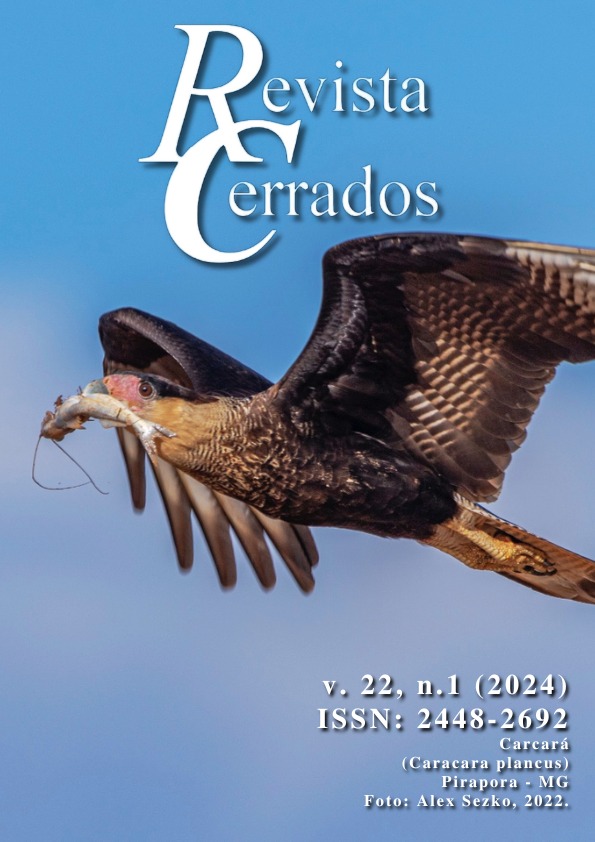Changes in land use and land cover in a watershed on the western edge of the Paraná Sedimentary Basin, in Campo Grande/MS
DOI:
10.46551/rc24482692202401Keywords:
Landscape transformation, Commodities, Livestock, DegradationAbstract
In this study, changes in land use and land cover were analyzed in a watershed located in an expanding soybean zone, transitioning between the plateau and the erosion scarp in the central region of the state of Mato Grosso do Sul. The analysis was conducted using the historical series from the MapBiomas Network, collection 7.1 (1985-2021). In the years 2021, marked by a drought situation, and 2023, with rainfall distribution within historical averages, vegetation radiometric indices were calculated from Sentinel-2 images. This refinement allows us to observe interannual changes in land cover and use, as well as the effects of drought on vegetation. In 1985, native vegetation consisting of forest formations, savannahs, grasslands, and wetlands occupied 29.16% of the watershed area. In 2021, native vegetation increased to 30.02%, primarily due to the natural regeneration in abandoned pasture areas on steep terrain. Throughout the analyzed period, the predominant land use class was pasture, occupying 50.04% of the area in 1985 and 37.41% in 2021. The reduction in pasture area is a result of the expansion of soybean cultivation, which accounted for 11.81% of the total watershed area in 2021. Despite the area being part of a sustainable use Conservation Unit, the observed degradation processes are like those in unprotected areas.
Downloads
References
ALVARES, C. A. et al. Köppen‟s climate classification map for Brazil. Meteorologische Zeitschrift, [S./l.], v. 22, n. 6, p. 711-728, 2014.
AMORIM, A. E. S.; CAPOANE, V. Classificação automatizada do relevo utilizando a ferramenta Geomorphons: estudo de caso para o município de Campo Grande - MS. Revista Brasileira de Geografia Física, [S./l.], v. 15, p. 750-766, 2022.
ARNETH, A.; BROWN, C.; ROUNSEVELL, M. D. A. Global models of human decision-making for land-based mitigation and adaptation assessment. Nature Climate Change, [S./l.], v. 4, n. 12, p. 550-557, 2014.
BOMBARDI, L. M. Atlas: Geografia do uso de agrotóxicos no Brasil e conexões com a União Europeia. São Paulo: FFLCH - USP, 2017 (Food and Agriculture Organization of the United Nations).
CAMPO GRANDE, Poder Executivo, Decreto Municipal n. 8.264, de 27 de julho de 2001. Cria a Área de Proteção Ambiental da Bacia do Córrego Ceroula – APA do Ceroula – localizada no município de Campo Grande-MS, e dá outras providências. Diário Oficial de Campo Grande - DIOGRANDE, Poder executivo. Campo Grande, MS. 2001.
CAPOANE, V.; CARVALHAL, H. O. D. Mudanças na cobertura e no uso da terra na bacia hidrográfica do córrego ceroula no período entre 1985 e 2021. Revista Pantaneira, [S./l.], v. 23, p. 1-18, 2024.
CAPOANE, V. Expansão da soja no estado de Mato Grosso do Sul no período entre 1988 e 2020. In: BARBOSA, E. F. F. M.; MARINHO, V. L. F.; GÜNTZEL, A. M. (Org.) Mato Grosso do Sul no início do século XXI: Integração e desenvolvimento urbano-regional. Campo Grande, MS: Life Editora, 2023. p. 25-38.
CAPOANE, V. Impactos do período seco e geadas no vigor da vegetação: estudo de caso para a bacia hidrográfica do córrego Guariroba, Campo Grande, Mato Grosso do Sul. Revista Cerrados, Montes Claros – MG, v. 20, n. 02, p. 221-241, jul./dez. 2022.
CAPOANE, V. Mapeamento dos pequenos reservatórios e análise dos impactos ambientais associados na bacia hidrográfica do córrego Guariroba, Campo Grande – MS. GEO UERJ (2007), [S./l.], v. 39, p. 1-23, 2021.
CARVALHAL, H. O. D.; CAPOANE, V. Caracterização Geoambiental da Bacia Hidrográfica do Córrego Ceroula, Mato Grosso do Sul. In: XIX SIMPÓSIO BRASILEIRO DE GEOGRAFIA FÍSICA APLICADA. Anais XIX SBGFA ... Rio de Janeiro, 2022. pg. 132-136.
CARVALHO, L. Valsa brasileira: do boom ao caos econômico. São Paulo: Todavia, 2018.
CEMTEC. Centro de Monitoramento do Tempo e do Clima de MS. Banco de dados 2024. Disponível em: https://www.cemtec.ms.gov.br/boletins-meteorologicos/. Acesso em: 05 fev. 2024.
CHABOUSSOU, F. Les plantes malades des pesticides. Paris: Editions Débard, 1980.
ESA – European Spatial Agency. Sentinel Application Platform – SNAP. Desktop implementation version 9.0.0. 2022. Disponível em: https://step.esa.int/main/download/snap-download/. Acesso em: 20 nov. 2023.
GRASSI, G. et al. The key role of forests in meeting climate targets requires science for credible mitigation. Nature Climate Change, [S./l.], v. 7, p. 220-226, 2017.
HANCOCK, G. R.; WILLGOOSE, G. R.; EVANS, K. G. Testing of the Siberia landscape evolution model using the Tin Camp Creek, Northern Territory, Australia, field catchment. Earth Surface Processes and Landforms, [S./l.], v.27, n.2, p.125-143, 2002.
HANCOCK, G. R.; MARTINEZ, C.; WELLS, T. Modelling and assessment of soil carbon variability at the point and hillslope scale. In: OXLEY, L.; KULASIRI, D. (Eds), MODSIM 2007. International Congress on Modelling and Simulation. Modelling and Simulation Society of Australia and New Zealand, 2007. p.1743-1748.
IBGE. Instituto Brasileiro de Geografia e Estatística. Mapeamento de recursos naturais do Brasil: Escala 1:250.000 – Documentação técnica. Rio de Janeiro: IBGE – Diretoria de Geociências, 2021.
IBGE. Instituto Brasileiro de Geografia e Estatística. SIDRA. Sistema IBGE de Recuperação Automática. Produção Agrícola Municipal
a. Disponível em: https://sidra.ibge.gov.br/tabela. Acesso em: 20 nov. 2023.
IBGE. Instituto Brasileiro de Geografia e Estatística. SIDRA. Sistema IBGE de Recuperação Automática. Produção Pecuária Municipal 2022b. Disponível em: https://sidra.ibge.gov.br/tabela/3939. Acesso em: 20 nov. 2023.
LACERDA FILHO, J. V. et al. Geologia e recursos minerais do estado de Mato Grosso do Sul - Escala 1:1.000.000. CPRM, 2006.
LINDSAY, J. B.; CREED, I. F. Removal of artifact depressions from digital elevation models: towards a minimum impact approach. Hydrological Processes, [S./l.], v. 19, n. 16, p. 3113-3126, 2005. DOI: 10.1002/hyp.5835
MAPBIOMAS. Rede MapBiomas coleção 7.1, 2023. Disponível em: https://mapbiomas.org/colecoes-mapbiomas-1?cama_set_language=pt-BR
MAPBIOMAS. Estatística de Acurácia, Coleção 7.1. 2023. Disponível em: https://plataforma.mapbiomas.org/. Acesso em: 18 dez. 2023.
MARENGO, J. A. et al. Increased climate pressure on the agricultural frontier in the Eastern Amazonia–Cerrado transition zone. Scientifc Reports, [S./l.], v. 12, n. 457, p. 1-10, 2022.
MOTTA, P. E. F. da et al. Levantamento de reconhecimento de baixa intensidade dos solos do Município de Campo Grande, MS. Rio de Janeiro: Embrapa Solos, 2013.
PIGNATI, W. A. et al. Distribuição espacial do uso de agrotóxicos no Brasil: uma ferramenta para a Vigilância em Saúde. Ciência & Saúde Coletiva, [S./l.], v. 22, n. 10, p. 3281-3293, out. 2017.
POPP, A. et al. Land-use protection for climate change mitigation. Nature Climate Change, [S./l.], v. 4, n. 12, p. 1095-1098, 2014.
POWERS, R. P.; JETZ, W. Global habitat loss and extinction risk of terrestrial vertebrates under future land-use-change scenarios. Nature Climate Change, [S./l.], v. 9, p. 323-329, 2019.
RIBEIRO, J. F.; WALTER, B. M. T. As principais fitofisionomias do bioma cerrado. In: SANO, S. M.; ALMEIDA, S. P. de (Ed.). Cerrado: ambiente e flora. Embrapa Cerrados. Brasília, DF: Embrapa Informação Tecnológica. p. 151-212, 2008.
ROUSE, J. W. et al. Monitoring vegetation systems in the great plains with ERTS. In: Earth Resources Technology Satellite‐1 Symposium, 3, Washington, 1973. Proceedings. Whashington: NASA, 1974, v.1, p. 309-317, 1973.
ROSA, R. Introdução ao Sensoriamento Remoto. 7. ed. Uberlândia: EDUFU, 2009.
ROSS, J. L. S. et al. Macroformas do relevo da América do Sul. Revista do Departamento de Geografia, [S./l.], v. 38, p. 58-69, 2019.
SANO, E. E. et al. Cerrado ecoregions: A spatial framework to assess and prioritize Brazilian savanna environmental diversity for conservation. Journal of Environmental Management, [S./l.], v. 232, p. 818-828, 2019.
SEMADUR. Secretaria Municipal de Meio Ambiente e Desenvolvimento Urbano. 2020. Arquivos vetoriais. Disponível: http://www.campogrande.ms.gov.br/semadur/arquivos-vetoriais-de-campo-grande/ e http://portal.capital.ms.gov.br/semadur/canaisTexto?id_can=5951. Acesso: 23 jan. 2020.
SONG X.-P. et al. Global land change from 1982 to 2016. Nature, [S./l.], v. 560, n. 7720, p. 639-643, 2018.
SOUZA, J. A elite do atraso. Rio de Janeiro: Estação Brasil, 2019.
SOUZA, J. A radiografia do golpe. Rio de Janeiro: Leya, 2016.
SOUZA, C. M. et. al. Reconstructing three decades of land use and land cover changes in Brazilian biomes with Landsat archive and earth engine. Remote Sensing, [S./l.], v. 12, n. 17, p. 1- 27, 2020.
VITOUSEK, P. M. et al. Human domination of Earth’s ecosystems. Science, [S./l.], v. 277, n. 5325, p. 494-499, 1997.
TYGEL, A. et al. Atlas dos agrotóxicos: fatos e dados sobre agrotóxicos na agricultura. 1. ed. Rio de Janeiro: Heinrich Böll, 2023.
WINKLER, K. et al. Global land use changes are four times greater than previously estimated. Nature Communications, [S./l.], v. 12, n. 2501, p. 1-10, 2021.
ZALLES, V. et al. Rapid expansion of human impact on natural land in South America since 1985. Science Advances, [S./l.], v. 7, n. 14, p. 1-11, 2021.
ZHONG, K. et al. Dynamic changes in temperature extremes and their association with atmospheric circulation patterns in the Songhua River Basin, China. Atmospheric Research, [S./l.], v. 190, p. 77-88, 2017.
Downloads
Published
How to Cite
License
Copyright (c) 2024 Revista Cerrados

This work is licensed under a Creative Commons Attribution-NonCommercial-NoDerivatives 4.0 International License.
In this journal, the copyrights for published articles belong to the author (s), with the rights of the first publication belonging to Revista Cerrados. The articles are publicly accessible, free to use, their own assignments, educational assignments and non-commercial applications.


















